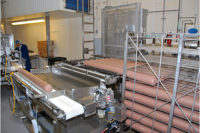For worker safety's sake
Meat and poultry plants have a variety of measures to safeguard workers, but getting employees to embrace the guidelines is essential for widespread success.

Keeping workers safe is an ongoing challenge for meat and poultry processors.
There is no shortage of regulations and initiatives to prevent injuries and reduce stress. But operators must include employees in the planning and implementation of programs and get them to commit to eliminating workplace incidents if safety is to become more than a buzzword.
To motivate companies to improve safety performance, while subsequently boosting employee morale, the Washington, D.C.-based North American Meat Institute (NAMI) honors top performing organizations with its Worker Safety Recognition Award. The most successful operations have multifaceted programs that feature ongoing worker training in a host of disciplines and a management team that continually demonstrates its commitment to the welfare of workers.
Safety award recipient Birchwood Foods, a Kenosha, Wis.-producer of fresh, frozen, raw and pre-cooked beef, pork and poultry products, has approximately 800 employees in three plants and extensively educates new workers on safety. It holds sessions during the initial orientation and every 30 days for the next four months, along with a six-month review and annual retraining.
“The more safety training someone gets, the more they understand the job hazards,” says Phyllis Murray, Birchwood vice president of human resources and safety, and a member of the NAMI Safety Committee. “It should not be one-time training and then hope the employee stays safe.”
Training topics include personal protective equipment (PPE), plant hazards, lockout/tagout awareness, machine guards, forklift awareness, chemical safety, accident reporting, emergency evacuation, hearing conservation, safe lifting techniques, facility security, electrical safety, pallet jack awareness, warning signs and tags, welding safety and ergonomics.
Doing an about-face
Ergonomics — which focuses on reducing injuries and disorders associated with the overuse of muscles, bad posture, and repeated tasks — is a plant priority.
Birchwood Foods workers, for instance, rotate among jobs so they do not overwork specific body parts. People packing boxes on a patty line using their left sides, for instance, might switch after a break to a station in where they favor their right sides. Long-term employees, meanwhile, sometimes undergo retraining and switch to less-strenuous jobs as their physical abilities change.
In addition to a Worker Safety Committee consisting of hourly employees that meet weekly and share safety concerns with management, a Safety Improvement Management Team considers ways of preventing injuries.
“When an incident occurs, it usually is the behavior of a person, such as putting their hands where they shouldn’t be or lifting something heavy alone that should have been a two-person job,” Murray says. “Our philosophy is zero tolerance for occurrences that are preventable, and every accident is preventable.”
Birchwood Foods has a stringent policy for disciplining safety violators. Workers who don’t follow machine lockout guidelines, for instance, get a three-day suspension. A second violation results in automatic termination. Among the challenges in enhancing safety is getting workers to speak up if they notice a colleague behaving in an unsafe manner, Murray says.
“They don’t want to be a bad guy or a tattletale,” she says. “But by building relationships, there is a culture change and they become more comfortable in addressing co-workers or bringing an issue to supervisors’ attention.”
Future safety concerns, meanwhile, will result in part from changes in laws regarding drug use, such as the legalization of marijuana, Murray says. “As society changes, our procedures have to change,” she says.
Learning the company way
Also evolving is the plant workforce. Hiring new employees often results in another set of safety issues. Many new workers, who are straight out of high school and on their first job, need to adjust to a manufacturing environment and the risks inherent to meat plants, says Andy Ripic, general manager of Wichita, Kan.-based Cargill Beef’s Wyalusing, Pa., plant. Generational differences between the young workers and their supervisors often results in communication problems.
“Getting, and holding, the attention of ‘Gen X’ and ‘Gen Next’ employees during the initial orientation phases of their employment is critical to our safety success,” Ripic says.
New workers go through a safety orientation process then must attend mandatory monthly safety meetings. The company also posts monthly safety messages covering a wide range of topics, such as slips, trips and falls, and working safely with electricity.
“We try to relate these bulletin board topics to situations employees would encounter at home, as well as in the workplace,” Ripic says. “If we can compel employees to practice safety when they are away from work, we have a much better chance of them practicing safety while at work.”
Cargill, which also was recognized by NAMI for its safety initiatives, is moving to reduce the number and severity of musculoskeletal disorders by providing a standardized ergonomics framework for all of its facilities. The program requires the formation of an Ergonomic or Safety Steering Committee made up of a facility’s general manager, operations managers, maintenance or engineering manager, health and safety manager, health services manager and at least one superintendent.
Other issues include dealing with the increasing amount of equipment that is designed and built in Europe and not compliant with U.S. safety regulations, Ripic says. Plants must either get the manufacturer to add safeguards required by the U.S. Occupational Safety and Health Administration (OSHA) or secure approval from the manufacturer to allow Cargill to make the necessary modifications, Ripic says.
“As the industry moves toward more consumer-ready protein products, we are faced with more complex production technology,” Ripic says. “That also requires that we remain vigilant and improve the technical skills of employees to ensure equipment is maintained in a safe and serviceable condition.”
The need for stringent safety measures is critical as the activities necessary to produce high-quality proteins can be risky, says Scott Hartter, Cargill vice president for environment, health and safety. Catastrophic injuries can result from mobile equipment use, equipment de-energizing, use of hazardous chemicals, elevated work and work in a confined space, he says.
“We must challenge ourselves to conduct our work in new and different ways to reduce our risk of incidents, as well as reduce the potential negative consequences when there is deviation from established processes and procedures, or human error,” Hartter says. “Understanding and minimizing the effects of errors are critical to reducing the potential for catastrophic injuries.”
Stay in the game
Such errors, meanwhile, often result from worker complacency, says LeRoy Edwards, director of safety and security for New Albany, Ohio-based Bob Evans Foods, another NAMI award winner which has about 800 employees in four plants. Edwards says it’s difficult to keep workers vigilant about safety when they are engaged in routine tasks and often thinking about other matters.
“One of the biggest challenges is motivating employees to work safely day in and day out,” Edwards says. “It’s easy for employees to become complacent and not put as much focus on the risks associated with their assignments. As such, we are constantly looking for ways to heighten engagement, safety awareness and excitement about safety.”
Such measures include having supervisors commend workers who are following safety protocols, while pointing out shortcomings in a positive manner, such as by saying, for instance, “We noticed you didn’t wear ear plugs correctly and this is the way to do it.”
There also is an emphasis on ergonomics. Plant employees rotate work stations every two to four hours so that there is less strain on specific body parts.
“We look at every individual regardless of age and how they can safely perform their task,” Edwards says. “That includes analyzing the type of equipment they use and even the type of stools they sit on.”
Yet, while wide-ranging measures are crucial for enhancing safety, operators still must demonstrate interest in their employees’ welfare if the workers are to adhere to the regulations, says Ron Bryant, corporate health and safety manager for Sugar Creek Packing Co., a Washington Courthouse, Ohio-based meat processor with about 1,700 employees in five plants and a NAMI safety award winner.
“You can have the best safety program in place, but if there is not total buy-in, it doesn’t do you any good,” he says.
Sugar Creek initiatives include having management and supervisors give workers their undivided attention when discussing plant issues to demonstrate support; having workers participate in twice-monthly Safety Committee meetings; and deploying boxes in break rooms into which where workers can drop notes to anonymously report the injuries and near misses they witness and suggest changes in plant operations that can enhance safety. The company also distributes safety literature and workers often wear shirts with safety mottos they create, such as “Safety is Number One” and “Come to Work and Don’t Go Home Hurt.”
Getting to know you
Adding to the need for ongoing safety messaging and training is the steady worker turnover in the protein sector, says Bobby Barragan, director of human resources for Case Farms Processing Inc., a Troutman, N.C.-based poultry processor and NAMI safety award recipient. Case Farms has about 3,200 workers in five plants.
The company’s activity includes weekly roundtable meetings at all plants with randomly selected employees who can express safety concerns with the general manager, plant manager and human resources leader.
Monthly safety meetings, meanwhile, often focus on seasonal issues, such as staying hydrated during the summer and proper driving techniques for winter conditions.
A key aim is having employees feel comfortable in interacting with management so they are more willing to express safety concerns and are receptive to suggestions and mandates, says Billy Holland, Case Farms safety director. Holland says he enhances rapport by often working alongside plant employees and assisting in such tasks as unloading trucks or changing tires.
Some workers also accompany managers during the frequent plant inspections, “which makes them more comfortable in what we want to accomplish with plant safety,” Holland says.
Sugar Creek also uses bi-lingual trainers to convey safety information in workers’ native languages. Barragan notes, for instance, that Case Farms even hired a Nepali speaking educator to converse with Nepali workers.
By demonstrating to workers that management cares about their well-being, while also educating the employees on optimal safety practices, meat and poultry processors have a powerful recipe for replacing apathy with enthusiasm. NP
Looking for a reprint of this article?
From high-res PDFs to custom plaques, order your copy today!









